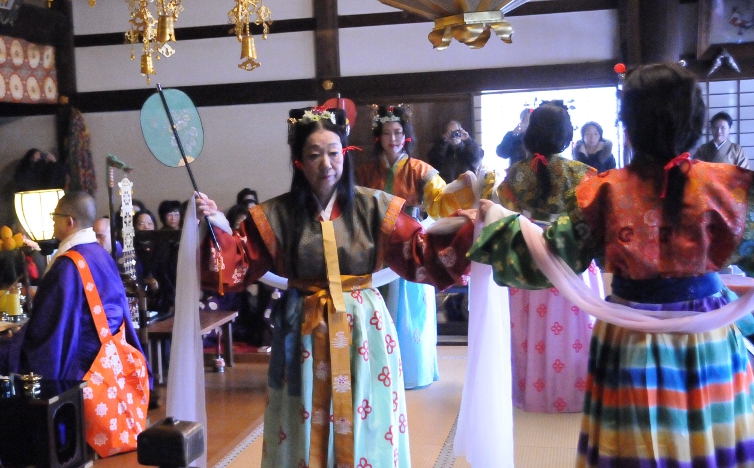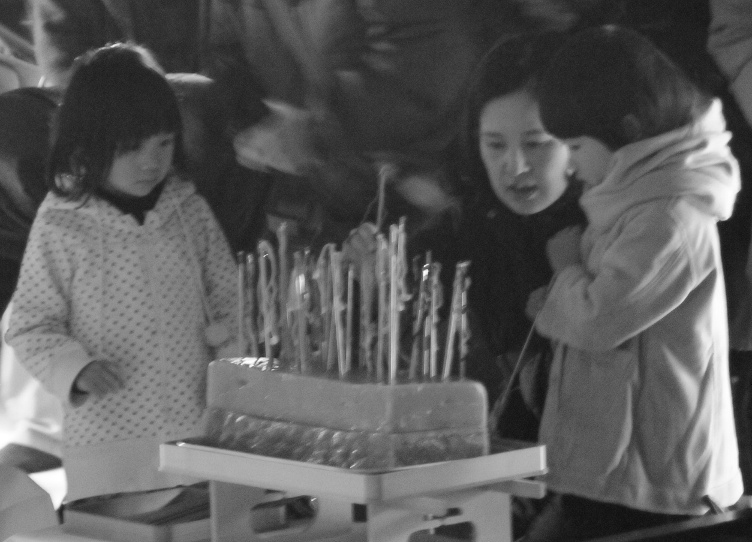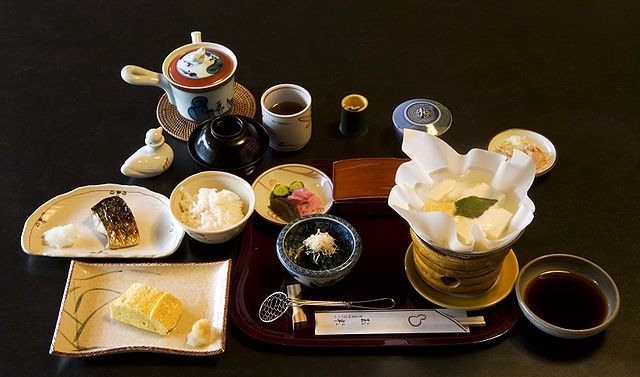I guess that the top three things associated with Japan are sushi, samurai, and geisha. While sushi is easily available all over the world these days, and samurai are readily identified as men with swords and that extra bit of honour, the world of the geisha is even nowadays a carefully guarded one where not everybody is allowed to enter, lest take part. This, as well as the fact that the hanamachi (geisha districts, literally “flower town”) are operating with ancient rules and traditions, the meaning of which has long been lost to the outside observer, has given rise to a number of misconceptions and misunderstandings even among Japanese.
It starts with the name: geisha means literally “art person”, she is a woman trained in a number of traditional Japanese arts and plays the part of hostess at parties generally visited by men. She is there to entertain the guests with singing, dancing, witty conversation, general attentiveness, and just the right amount of flirtation; in short, she is there to embody that image of the perfect woman every man fantasizes about – the perfect unattainable woman, because she will always go home alone.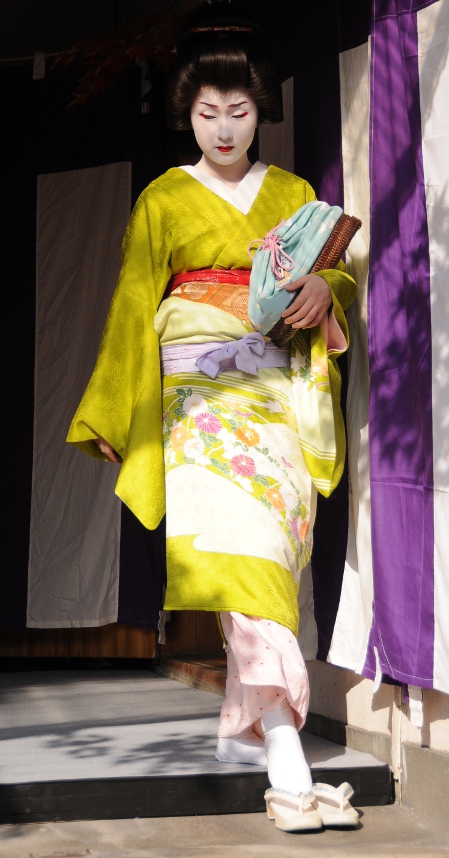 Like in many traditional Japanese arts, the first geisha were men, as women were not allowed to go to parties and mingle with men. In the 18th century however, women began to appear as geisha (how this came to pass is unclear), and they quickly became very popular of course. Geisha were independent and worked for themselves, and the brothels or oiran felt threatened by what they saw as competition. So, the government set up rules what geisha were allowed to wear, and how, where, and when they could entertain. Instead of curbing the business, however, this only fanned the flames, and geisha became hugely popular – in the 1920s, there were about 70.000 geisha all over Japan.
Like in many traditional Japanese arts, the first geisha were men, as women were not allowed to go to parties and mingle with men. In the 18th century however, women began to appear as geisha (how this came to pass is unclear), and they quickly became very popular of course. Geisha were independent and worked for themselves, and the brothels or oiran felt threatened by what they saw as competition. So, the government set up rules what geisha were allowed to wear, and how, where, and when they could entertain. Instead of curbing the business, however, this only fanned the flames, and geisha became hugely popular – in the 1920s, there were about 70.000 geisha all over Japan.
In these old days, girls as young as five or six started working and training at an okiya (geisha house). Not few of them were sold by their poor parents to the okiya and had to work there until they could repay the costs for their training. Nowadays becoming a geisha is a normal, albeit somewhat rare career choice for a girl. They usually enter an okiya at 18 (in Kyoto at 16) and start the demanding training of five years until they – at least the most determined ones of them – give their debut as geisha.
A typical training begins with the application of the girl to the okasan (mother) of an okiya. If she is accepted, the okasan will pay for her training and also act as her manager, and the girl will move into the okiya as a shikomi, essentially a maid helping around the house. She will now try to find a mentor among the geisha in the okiya, and once she has been accepted by her onesan (older sister), the so called misedashi ceremony will turn her into a maiko, an apprentice geisha. This is the time when she adopts a stage name that will be hers throughout her career, and often the geisha in an okiya share the first syllable of their stage names. 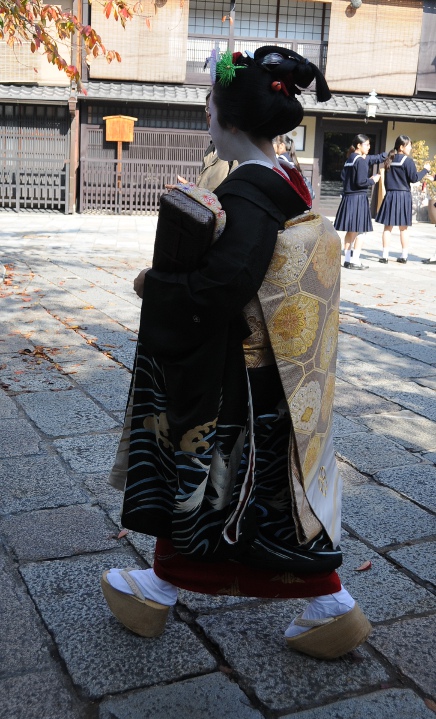 Part of a maiko’s training will be conducted at a kaburenjo, a training school for geisha, where different types of art are taught: ikebana (flower arranging), shodoh (calligraphy), sadoh (tea ceremony), and traditional Japanese dance and music (shamisen, koto, fue, etc.). Another part of the training is learning to speak the dialect of the local hanamachi, and how to entertain all types of men and what to do at parties in general. For that, the maiko will accompany her onesan, but does this only to observe – and to be introduced and to make connections for her future career. Finally, there are intricacies of polite Japanese behaviour to learn: whom to greet first for example, or how deep to bow. This happens mainly by interacting with the other people in the hanamachi, by visiting other okiya or teahouses, for example.
Part of a maiko’s training will be conducted at a kaburenjo, a training school for geisha, where different types of art are taught: ikebana (flower arranging), shodoh (calligraphy), sadoh (tea ceremony), and traditional Japanese dance and music (shamisen, koto, fue, etc.). Another part of the training is learning to speak the dialect of the local hanamachi, and how to entertain all types of men and what to do at parties in general. For that, the maiko will accompany her onesan, but does this only to observe – and to be introduced and to make connections for her future career. Finally, there are intricacies of polite Japanese behaviour to learn: whom to greet first for example, or how deep to bow. This happens mainly by interacting with the other people in the hanamachi, by visiting other okiya or teahouses, for example.  Once the training of a maiko is completed, she will make her debut as a geisha after a ceremony called eriage, which literally means “turning the collar” of her underkimono from a red to a white one. This is only one way of distinguishing maiko and geisha. The appearance of a maiko is usually that of a young girl, with very colourful kimono and bright obi. A maiko’s kimono has long sleeves that almost reach to the floor; most often they wear their obi in a long dangling style to show off the pattern. To avoid trailing the expensive kimono on the floor, they must wear 10 cm high wooden okobo, and a part of their earliest training consists of learning how to walk in them. Maiko also have an elaborate hairstyle that includes many colourful hair ornaments and is difficult to maintain.
Once the training of a maiko is completed, she will make her debut as a geisha after a ceremony called eriage, which literally means “turning the collar” of her underkimono from a red to a white one. This is only one way of distinguishing maiko and geisha. The appearance of a maiko is usually that of a young girl, with very colourful kimono and bright obi. A maiko’s kimono has long sleeves that almost reach to the floor; most often they wear their obi in a long dangling style to show off the pattern. To avoid trailing the expensive kimono on the floor, they must wear 10 cm high wooden okobo, and a part of their earliest training consists of learning how to walk in them. Maiko also have an elaborate hairstyle that includes many colourful hair ornaments and is difficult to maintain.
One of the things many maiko choose to do once they turn into a geisha is to cut off their hair and wear wigs instead. This saves them hours at the hairdresser’s each week, and now they can use real pillows instead of the tiny ones that allow no movement that could destroy the hairdo in the night. In general, a geisha’s appearance is more subdued than that of a maiko, as a geisha represents a mature woman. A geisha’s kimono is less ornate and colourful, the sleeves are much shorter, and the obi is worn in a more compact way. Another boon of being a geisha is that the more simple kimono now allows them to wear normal zori sandals, instead of the okobo. 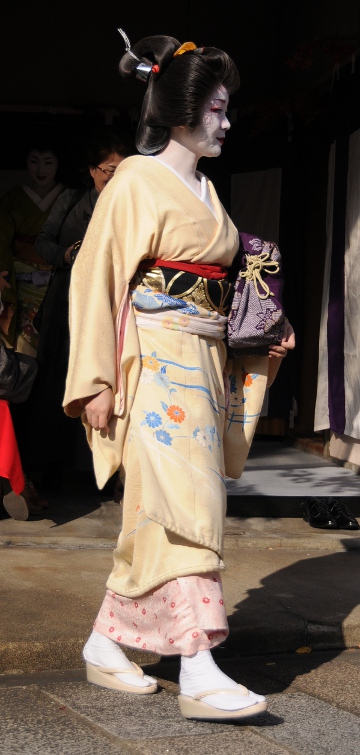 These are the most obvious changes from maiko to geisha, but there are many little details only the truly initiated can spot. Maiko’s hairstyles and collar patterns change from year to year; the more mature a maiko or geisha, the less flaunting her kimono becomes as she is now able to rely on her skills rather than to impress with her dress; and there are people who can tell, just by looking at the kimono and hair ornaments of a maiko which month of the year it is.
These are the most obvious changes from maiko to geisha, but there are many little details only the truly initiated can spot. Maiko’s hairstyles and collar patterns change from year to year; the more mature a maiko or geisha, the less flaunting her kimono becomes as she is now able to rely on her skills rather than to impress with her dress; and there are people who can tell, just by looking at the kimono and hair ornaments of a maiko which month of the year it is.
Nowadays, geisha are not only accomplished entertainers, but also smart businesswomen. In fact, the hanamachi are entirely run by women – from the maiko, their big sisters and mothers, to the owners of the teahouses that employ them. All geisha are unmarried but I guess boyfriends are allowed these days. A geisha getting married marks the time of her retirement, which is celebrated by the final ceremony of hiki iwai. She may now stop taking classes and can move out of her okiya. Often, however, retired geisha open their own teahouse or okiya and stay in the hanamachi in this capacity.  A private evening with a geisha is almost prohibitively expensive, which may be one reason why the number of geisha is dwindling – there are less than 1000 in Japan these days, mostly in Kyoto and Tokyo. There are some public performances throughout the year though, and occasions where you can see maiko and geisha walking the streets on the way to their work, especially in Kyoto’s Gion district. The photos here were taken at a public ceremony last month, by the way.
A private evening with a geisha is almost prohibitively expensive, which may be one reason why the number of geisha is dwindling – there are less than 1000 in Japan these days, mostly in Kyoto and Tokyo. There are some public performances throughout the year though, and occasions where you can see maiko and geisha walking the streets on the way to their work, especially in Kyoto’s Gion district. The photos here were taken at a public ceremony last month, by the way.
 A Japanese teenager living abroad suddenly misses her heritage and identity: What does it mean to be Japanese? On her quest for an answer she discovers the hanamachi, the geisha districts. Enthralled by this fantasy world of beautiful kimono wearing women and ancient customs, she decides to become the most Japanese woman of them all – and enters the hanamachi in Kyoto at age 15 to become a geisha. Given the name Komomo as an apprentice maiko, she starts a demanding training lasting five years to fulfill her dream.
A Japanese teenager living abroad suddenly misses her heritage and identity: What does it mean to be Japanese? On her quest for an answer she discovers the hanamachi, the geisha districts. Enthralled by this fantasy world of beautiful kimono wearing women and ancient customs, she decides to become the most Japanese woman of them all – and enters the hanamachi in Kyoto at age 15 to become a geisha. Given the name Komomo as an apprentice maiko, she starts a demanding training lasting five years to fulfill her dream. 


